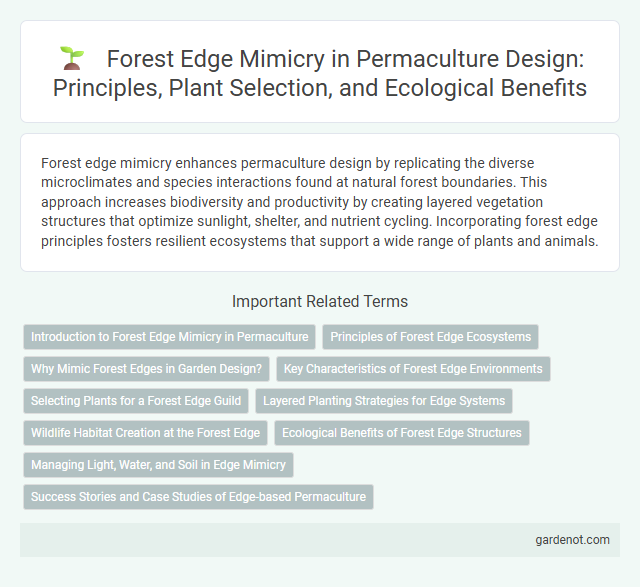Forest edge mimicry enhances permaculture design by replicating the diverse microclimates and species interactions found at natural forest boundaries. This approach increases biodiversity and productivity by creating layered vegetation structures that optimize sunlight, shelter, and nutrient cycling. Incorporating forest edge principles fosters resilient ecosystems that support a wide range of plants and animals.
Introduction to Forest Edge Mimicry in Permaculture
Forest edge mimicry in permaculture replicates the transitional zone between a forest and open land, fostering biodiversity and resilience by integrating layered plant species such as canopy trees, shrubs, and ground covers. This technique enhances microclimates, improves soil health through natural mulching, and supports beneficial wildlife habitats. Mimicking forest edges optimizes resource use, water retention, and nutrient cycling, creating sustainable, productive ecosystems.
Principles of Forest Edge Ecosystems
Forest edge ecosystems exhibit high biodiversity and productivity by integrating diverse plant species that create microclimates and resource gradients. Key principles include maximizing vertical and horizontal layering to enhance light capture and nutrient cycling, and fostering symbiotic relationships among flora and fauna for ecosystem resilience. Emulating these natural patterns in permaculture promotes sustainable land use and robust food systems.
Why Mimic Forest Edges in Garden Design?
Mimicking forest edges in garden design enhances biodiversity by creating diverse microclimates that support a wide range of plant and animal species. These transitional zones offer increased sunlight and nutrient availability, promoting vigorous plant growth and natural pest control. Integrating forest edge principles fosters resilient ecosystems, improves soil health, and maximizes space efficiency in permaculture gardens.
Key Characteristics of Forest Edge Environments
Forest edge environments exhibit increased biodiversity due to the unique microclimate created by the transition between dense forest and open land, promoting higher light availability and varied soil moisture levels. These ecotones support diverse plant species adapted to fluctuating conditions such as partial shade, wind exposure, and nutrient gradients. Forest edge mimicry in permaculture leverages these characteristics by integrating multi-layered vegetation, fostering habitat connectivity, and enhancing ecosystem resilience.
Selecting Plants for a Forest Edge Guild
Selecting plants for a forest edge guild involves choosing species that thrive in transitional zones between forest and open land, such as nitrogen-fixing trees, shade-tolerant shrubs, and perennial herbs. Integrating dynamic accumulators, pollinator attractors, and ground cover species enhances nutrient cycling, biodiversity, and soil stabilization. Emphasizing native and multifunctional plants supports ecosystem resilience while optimizing resource use in permaculture forest edge designs.
Layered Planting Strategies for Edge Systems
Forest edge mimicry in permaculture employs layered planting strategies to create multifunctional edge systems that maximize biodiversity and productivity. By integrating canopy trees, understory shrubs, ground covers, and root crops in vertical zones, these designs replicate natural forest edges, promoting microclimate regulation and resource efficiency. Layered planting enhances soil health, supports wildlife habitats, and increases yield through synergistic plant interactions in edge environments.
Wildlife Habitat Creation at the Forest Edge
Forest edge mimicry enhances wildlife habitat creation by replicating natural ecotones, promoting biodiversity through layered vegetation structures that provide food, shelter, and breeding sites for diverse species. Incorporating native plants with varying heights and seasonal cycles supports pollinators, birds, and small mammals, fostering ecological resilience. This approach stabilizes soil, regulates microclimates, and facilitates wildlife corridors crucial for ecosystem connectivity in permaculture design.
Ecological Benefits of Forest Edge Structures
Forest edge mimicry enhances biodiversity by creating transitional habitats that support diverse species, including pollinators, birds, and beneficial insects. These edge structures improve microclimates by regulating temperature and moisture levels, promoting soil health and nutrient cycling crucial for sustainable ecosystem function. Integrating forest edge designs in permaculture systems fosters natural pest control and increases resilience against environmental stressors, boosting overall ecological stability.
Managing Light, Water, and Soil in Edge Mimicry
Forest edge mimicry in permaculture strategically manages light by creating transitional zones that optimize sunlight exposure for diverse plant species. Water management includes capturing and directing runoff to maintain soil moisture, supporting plant resilience and growth. Soil health is enhanced through layering organic matter and fostering microbial activity, mimicking natural forest edge nutrient cycles to sustain ecosystem productivity.
Success Stories and Case Studies of Edge-based Permaculture
Forest edge mimicry in permaculture has transformed degraded landscapes by replicating the natural biodiversity and productivity found at forest margins, fostering resilient ecosystems. Case studies from temperate and tropical regions reveal significant increases in crop yields, biodiversity, and soil health by strategically planting layered vegetation that supports mutualistic relationships among species. Success stories include the restoration of arid lands in Australia and increased food security in rural Kenya, demonstrating the scalability and sustainability of edge-based permaculture design.
Forest edge mimicry Infographic

 gardenot.com
gardenot.com